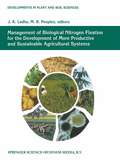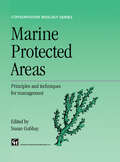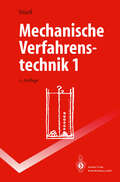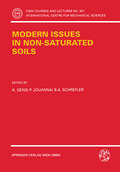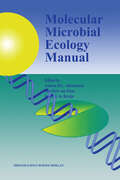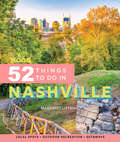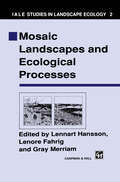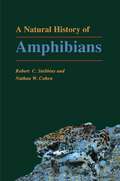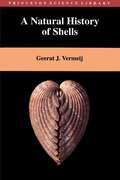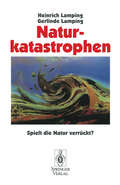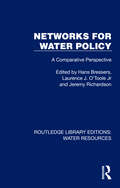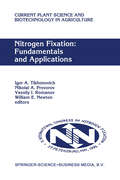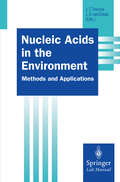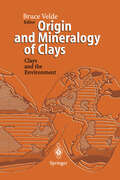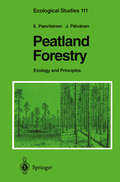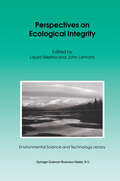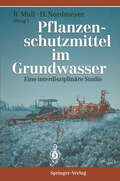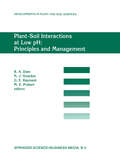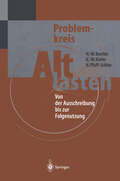- Table View
- List View
Management of Biological Nitrogen Fixation for the Development of More Productive and Sustainable Agricultural Systems: Extended versions of papers presented at the Symposium on Biological Nitrogen Fixation for Sustainable Agriculture at the 15th Congress of Soil, Acapulco, Mexico, 1994 (Boston Studies in the Philosophy and History of Science)
by J. K. Ladha, M. B. PeoplesTable 1. Global allocation of arable land between different com modities Globally, cereal cropping dominates cultivated land Commodities' Proportion of land area use (around 50% of total area, Table 1). The remain (%) ing arable land is used for production of oilseed, fibre, or food and cash crops. In addition, vast areas are Cereals maintained under temporary or permanent pasture for Wheat 16 forage production (2-3 fold greater than the total area Rice 10 under cultivation and permanent crop; Table 1, Fig. Maize 9 1). All cultivated crops, except for legumes (pulses All other cereals 13 and legume oil seeds) require the soil to provide rel Total 48 atively large amounts of nitrogen (N). It is necessary for the three most important cereals, wheat (Triticum Legumes aestivum), rice (Oryza sativa) and maize (Zea mays), Legume pulses 5 to take up 20 to 40 kg soil N ha -lover a period of 3 Legume oilseeds 6 to 5 months to satisfy the N requirements of the seed and supporting vegetative structure for each tonne of Total II grain produced (e. g. Fig. 2; Myers, 1988). Produc tive pastures on the other hand may assimilate> 100 Other crops I kg N ha- each annum, of which 50 to 90% will be Other oilseeds 6 consumed by livestock in intensively grazed systems Beverages / Tobacco 7 (Ledgardy, 1991; Thomas, 1995).
Marine Protected Areas: Principles and techniques for management (Conservation Biology #5)
by SusanGubbayMarine protected areas (MPAs) have an important role in marine conserva tion programmes around the world. Although most have been established relatively recently when compared with protected areas on land, there is considerable expertise on their identification, setting up and management. Some techniques have been adapted from those used on land. Others are novel, and unique to marine conservation. The chapters in this book give an insight into this fast developing field where experiment and innovation work alongside techniques which have been tried and tested. The guiding princi ples behind key stages in the setting up and management of MP As are described, and case studies illustrate how they have worked. While it is most encouraging to read about the successes, the case studies also point to difficulties which have been encountered. Not all of the examples are new or recent but, together, they illustrate what is happening in this field.
Markets, the State and the Environment: Towards Integration
Markets, the State and the Environment provides an introduction and interdisciplinary, critical overview of the case for a more market-based approach to environmental policy, taking stock of the key theoretical debates and a selection of recent policy developments in Europe, the US and Australia. The anthology compares and evaluates a wide range of market-based policy instruments (including taxes, charges and tradeable permits, privatisation and the encouragement of self-regulation) against the experience of the traditional regulatory approach in relation to the criteria of environmental effectiveness, efficiency, democratic participation, and social equity. The debate about environmental policy tools is also located in the context of the changing relationship between the state and the market in an increasingly interdependent world.
Mechanische Verfahrenstechnik 1 (Springer-Lehrbuch)
by Matthias StießBand 1 dieses zweibändigen Lehrbuches gibt dem Lernenden aufbauend auf den Grundlagen einen Einstieg in die verfahrenstechnische Behandlung der vielfältigen Probleme mit dispersen Stoffen. Partikeln und disperse Systeme und ihre wichtigsten Wechselwirkungen mit dem umgebenden Fluid (Flüssigkeit und Gas) und miteinander (Haftkräfte) werden behandelt. Partikelmeßtechnik, das Lagern und Fließen von Schüttgütern, Feststoffmischen, Rühren und das Klassieren sind weitere Themen. Jedes Kapitel enthält außer den Beispielen im Text noch einen Abschnitt mit Übungsaufgaben und durchgerechneten Lösungen.
Modern Issues in Non-Saturated Soils (CISM International Centre for Mechanical Sciences #357)
by A. Gens P. Jouanna B. A. SchreflerCoupling phenomena in non-saturated soils are fast becoming a headache for at least one of the following reasons: the large number of equations and unknowns, the complex T.H.M. behaviour of the soils, the sophisticated instrumentation required and/or the numerical instability encountered. If this is precisely your headache, read about the problem - and solutions to it - in "Modern Issues in Non-Saturated Soils”.
Molecular Ecology of Aquatic Microbes (Nato ASI Subseries G: #38)
by Ian JointA NATO ASI on "Molecular Ecology of Aquatic Microbes" was held at II Ciocco, Lucca, Italy from 28 August - 9 September 1994. The aims of the ASI were to evaluate the potential for molecular biology to solve some important questions in aquatic microbiology, particularly in relation to biogeochemical cycling and microbial physiology. Techniques developed by molecular biologists have now been adopted by a wide range of scientific disciplines. In the last 5 years, aquatic microbial ecologists have begun to incorporate these methods into their research and, as a result, are developing a much clearer understanding of phylogenetic diversity, the molecular basis of physiological acclimations and the transduction of environmental signals and organism responses. The aim of this ASI was to assess progress in this new field of research, to compare and describe techniques and experimental approaches, and to foster communication between disciplines. The ASI offered an excellent opportunity to bring together aquatic ecologists with molecular biologists and to encourage efficient technology transfer. The meeting of information on the status provided a forum for detailed and broad exchange and trends of aquatic molecular ecology and to assess how emerging molecular techniques might solve some important problems in ecology which have prove intractable because of lack of appropriate methodologies.
Molecular Microbial Ecology Manual
by A. D. Akkermans Jan Dirk Van Elsas F. J. De BruijnFor a long time microbial ecology has been developed as a distinct field with in Ecology. In spite of the important role of microorganisms in the environ ment, this group of 'invisible' organisms remained unaccessable to other ecologists. Detection and identification of microorganisms remain largely dependent on isolation techniques and characterisation of pure cultures. We now realise that only a minor fraction of the microbial community can be cultivated. As a result of the introduction of molecular methods, microbes can now be detected and identified at the DNA/RNA level in their natural environment. This has opened a new field in ecology: Molecular Microbial Ecology. In the present manual we aim to introduce the microbial ecologist to a selected number of current molecular techniques that are relevant in micro bial ecology. The first edition of the manual contains 33 chapters and an equal number of additional chapters will be added this year. Since the field of molecular ecology is in a continuous progress, we aim to update and extend the Manual regularly and will invite anyone to deposit their new protocols in full detail in the next edition of this Manual.
Moon 52 Things to Do in Nashville: Local Spots, Outdoor Recreation, Getaways
by Margaret LittmanFrom that venue you haven&’t made it to yet to the weekend in the Smokies you keep meaning to plan, experience something new right here at home with Moon 52 Things to Do in Nashville.Cool things to do in and around the city: Get your hands dirty at a maker studio, discover a new museum, or get to know some of the local artists on Jefferson Street. Take a dance lesson or songwriting class, scope out thrift stores, or get fitted for custom-made cowboy boots. Catch an up-and-comer at Two Old Hippies or go backstage at the Ryman. Take your bike to the Shelby Bottoms Greenway and grab a beer as a post-ride reward. Feast on Kurdish food, test your tastebuds on hot chicken, or taste your way through Southern barbecue historyDay trips and weekend getaways: Sip samples at distilleries along the Tennessee Whiskey Trail, or groove to the blues in Memphis. Go whitewater rafting on the Ocoee, take the car out for cruise along the Natchez Trace Parkway, or go camping in Great Smoky Mountains National ParkExperiences broken down by category: Find ideas for each season, activities with kids, outdoor adventures, historic sites, live music, and moreA local's advice: Whether it&’s a bucket-list venue or an under-the-radar vintage shop, local author Margaret Littman knows the ins and outs of NashvilleInspirational full-color photos throughout Easy-to-scan planning tips: Addresses and time allotment, plus tips for avoiding the crowds if you're heading to a popular attractionWhat are you doing this weekend? Try something new with Moon 52 Things to Do in Nashville. About Moon Travel Guides: Moon was founded in 1973 to empower independent, active, and conscious travel. We prioritize local businesses, outdoor recreation, and traveling strategically and sustainably. Moon Travel Guides are written by local, expert authors with great stories to tell—and they can't wait to share their favorite places with you.For more inspiration, follow @moonguides on social media.
Mosaic Landscapes and Ecological Processes
by L. Hansson L. Fahrig G. MerriamThis series presents studies that have used the paradigm of landscape ecology. Other approaches, both to landscape and landscape ecology are common, but in the last decade landscape ecology has become distinct from its predecessors and its contemporaries. Landscape ecology addresses the relationships among spatial patterns, temporal patterns and ecological processes. The effect of spatial configurations on ecological processes is fundamental. When human activity is an important variable affecting those relationships, landscape ecology includes it. Spatial and temporal scales are as large as needed for comprehension of system processes and the mosaic included may be very heterogeneous. Intellec tual utility and applicability of results are valued equally. The Inter national Association for Landscape Ecology sponsors this series of studies in order to introduce and disseminate some of the new knowledge that is being produced by this exciting new environmental science. Gray Merriam Ottawa, Canada Foreword This is a book about real nature, or as close to real as we know - a nature of heterogeneous landscapes, wild and humanized, fine-grained and coarse-grained, wet and dry, hilly and flat, temperate and not so temper ate. Real nature is never uniform. At whatever spatial scale we examine nature, we encounter patchiness. If we were to look down from high above at a landscape of millions of hectares, using a zoom lens to move in and out from broad overview to detailed inspection of a square meter we would see that patterns visible at different scales overlay one another.
A Natural History of Amphibians
by Robert C. Stebbins Nathan W. CohenThis is a book for all readers who want to learn about amphibians, the animal group that includes frogs, toads, salamanders, and caecilians. It draws on many years of classroom teaching, laboratory experience, and field observation by the authors. Robert Stebbins and Nathan Cohen lead readers on a fascinating odyssey as they explore some of nature's most interesting creatures, interspersing their own observations throughout the book. A Natural History of Amphibians can serve as a textbook for students and independent learners, as an overview of the field for professional scientists and land managers, and as an engaging introduction for general readers. The class Amphibia contains more than 4,500 known living species. New species are being discovered so rapidly that the number may grow to more than 5,000 during our lifetimes. However, their numbers are being rapidly decimated around the globe, largely due to the encroachment of humans on amphibian habitats and from growing human-caused environmental pollution, discussed at length in the final chapter. The authors focus our attention on the "natural history" of amphibians worldwide and emphasize their interactions with their environments over time: where they live; how they reproduce; how they have been affected by evolutionary processes; what factors will determine their destinies over time. Through the experienced eyes of the authors, who are skilled observers, we come to see and understand the place of amphibians in the natural world around us.
A Natural History of Shells (PDF)
by Geerat J. VermeijGeerat Vermeij wrote this "celebration of shells" to share his enthusiasm for those supremely elegant creations and what they can teach us about nature. Most popular books on shells emphasize the identification of species, but Vermeij uses shells as a way to explore major ideas in biology. How are shells built? How do they work? How did they evolve? The author lucidly and charmingly demonstrates how shells give us insights into the lives of animals in our own day as well as in the distant geological past.
The Naturalist in Britain: A Social History
by David Elliston AllenAt once a major resource for historians of science and an excellent introduction to natural history for the general reader, David Allen's The Naturalist in Britain established a precedent for investigating natural history as a social phenomenon. Here the author traces the evolution of natural history from the seventeenth to the early twentieth centuries, from the "herbalizings" of apprentice apothecaries to the establishment of national reserves and international societies to the emergence of natural history as an organized discipline. Along the way he describes the role of scientific ideas, popular fashion, religious motivations, literary influences, the increase of leisure time and disposable income, and the tendency of like-minded persons to form clubs. His comprehensive and entertaining discussion creates a vibrant portrait of a scientific movement inextricably woven into a particular culture.
The Naturalist in Britain: A Social History
by David Elliston AllenAt once a major resource for historians of science and an excellent introduction to natural history for the general reader, David Allen's The Naturalist in Britain established a precedent for investigating natural history as a social phenomenon. Here the author traces the evolution of natural history from the seventeenth to the early twentieth centuries, from the "herbalizings" of apprentice apothecaries to the establishment of national reserves and international societies to the emergence of natural history as an organized discipline. Along the way he describes the role of scientific ideas, popular fashion, religious motivations, literary influences, the increase of leisure time and disposable income, and the tendency of like-minded persons to form clubs. His comprehensive and entertaining discussion creates a vibrant portrait of a scientific movement inextricably woven into a particular culture.
Naturkatastrophen: Spielt die Natur verrückt?
by Heinrich Lamping Gerlinde LampingNaturkatastrophen vernichten jedes Jahr Tausende von Menschenleben - spielt die Natur verrückt? Die Autoren zeigen, wie aus den Launen der Natur Katastrophen werden und welchen Anteil der Mensch daran hat.
Networks for Water Policy: A Comparative Perspective (Routledge Library Editions: Water Resources)
Network models for analysing public policy have become widely used in recent years. This volume, originally published in 1995, assesses the network idea by applying a common perspective on network analysis to the constellations involved in water policy formation and implementation in England and Wales, Germany, Hungary, the Netherlands, the USA and at the level of the EU. Water policy – addressing basic human needs for the supply of adequate surface and groundwater as well as for the maintenance and improvement of water quality, is an increasingly salient subject. Each case covered in this volume treats the issues of water policy network composition and structure, and determinants of network characteristics, as well as documenting the influence of the networks on policy developments towards more network openness, emulation of business behaviour nd less domination by traditional professional groups such as engineers. Essays by the editors provide a common analytical perspective and offer both explicitly-comparative conclusions and evidence-based assessments of the strengths and limitations of the network perspective.
Networks for Water Policy: A Comparative Perspective (Routledge Library Editions: Water Resources)
by Hans Bressers Laurence J. O’Toole Jr Jeremy RichardsonNetwork models for analysing public policy have become widely used in recent years. This volume, originally published in 1995, assesses the network idea by applying a common perspective on network analysis to the constellations involved in water policy formation and implementation in England and Wales, Germany, Hungary, the Netherlands, the USA and at the level of the EU. Water policy – addressing basic human needs for the supply of adequate surface and groundwater as well as for the maintenance and improvement of water quality, is an increasingly salient subject. Each case covered in this volume treats the issues of water policy network composition and structure, and determinants of network characteristics, as well as documenting the influence of the networks on policy developments towards more network openness, emulation of business behaviour nd less domination by traditional professional groups such as engineers. Essays by the editors provide a common analytical perspective and offer both explicitly-comparative conclusions and evidence-based assessments of the strengths and limitations of the network perspective.
Nitrogen Fixation: Proceedings of the 10th International Congress on Nitrogen Fixation, St. Petersburg, Russia, May 28—June 3, 1995 (Current Plant Science and Biotechnology in Agriculture #27)
by Igor A. Tikhonovich Nikolai A. Provorov Vassily I. Romanov William E. NewtonNitrogen fixation research is presented as a rapidly developing, synergistic area of modern science, using the methods of, and accumulating data from, many fundamental branches of biology and chemistry. These include catalytic mechanisms, protein structure and function, molecular organization of genes and the regulation of their activities, biochemistry of plants and microorganisms, the signalling and surface interactions between organisms, microbial taxonomy and evolution, formal and population genetics, and ecology. The relationships between biological nitrogen fixation research and different branches of applied biology are addressed and analyzed, such as: the monitoring of genetically engineered microorganisms, selection of plant-associated microbes, plant breeding, increasing the protein content of crops, providing ecologically safe food production, and diminishing the chemical pollution of the environment. Immediate impacts and long-term prospects for nitrogen fixation research are presented: both fundamentals and applications.
Nucleic Acids in the Environment (Springer Lab Manuals)
by Jack T. Trevors J. Dick Van ElsasMolecular biological techniques such as DNA/RNA extraction and purification, and especially the polymerase chain reaction, PCR, are rapidly gaining interest also in related fields, such as microbiology or environmental sciences. They offer new approaches and opportunities for the determination of microbial cells, DNA and RNA from soils, roots, rhizospheres, sediments and aquatic environments. Detailed protocols for these applications are described in this manual.
Origin and Mineralogy of Clays: Clays and the Environment
by BruceVeldeOrigin and Mineralogy of Clays, the first of two volumes, lays the groundwork for a thorough study of clays in the environment. The second volume will deal with environmental interaction. Going from soils to sediments to diagenesis and hydrothermal alteration, the book covers the whole spectrum of clays. The chapters on surface environments are of great relevance in regard to environmental problems in soils, rivers and lake-ocean situations, showing the greatest interaction between living species and the chemicals in their habitat. The book is of interest to scientists and students working on environmental issues.
Peatland Forestry: Ecology and Principles (Ecological Studies #111)
by Eero Paavilainen Juhani PäivänenPerspectives on Ecological Integrity (Environmental Science and Technology Library #5)
by JohnLemons LauraWestraConcepts of ecological integrity have recently been proposed to facilitate enhanced protection of biological and ecological resources against the threat of human activities. The promotion of ecological integrity as a basis for public policy and decision making stems from scientists and others concerned about the threats of human activities to ecosystems and species, and from philosophers attempting to derive a more suitable ethic to guide the relationships between humans and the non-human environment. Although ecological integrity has been proposed as a norm for public policy and decision making, the concept is relatively new and therefore the underlying scientific and philosophical rationales have not been fully developed. This book offers a number of perspectives to stimulate and inform future discussion on the importance and consequences of ecological integrity for science, morality and public policy. Audience: Environmental professionals, whether academic, governmental or industrial, or working in the private consultancy sector. Also suitable as an upper-level reference text.
Pflanzenschutzmittel im Grundwasser: Eine interdisziplinäre Studie
by P. W. Boochs H. LiethUnter Einbehiehung von Ergebnissen nationaler und internationaler Arbeitsgruppen faßt das vorliegende Buch die gesammelten Erkenntnisse zusammen.
Plant-Soil Interactions at Low pH: Proceedings of the Third Intenational Symposium on Plant-Soil Interactions at Low pH, Brisbane, Queensland, Australia, 12–16 September 1993 (Developments in Plant and Soil Sciences #64)
by R. A. Date N. J. Grundon G. E. Rayment M. E. ProbertThe understanding of plant-soil interactions in acid soils is important for improved food production in many parts of the world. The context of the book touches on basic and applied aspects of the physics, chemistry and biology of acid soils and their effect on growth of plants. It contains a large section on management of acid soils for plant (food) production and on socioeconomic aspects of management of acid soils. This is important because a large portion of the world's acid soils occurs in less developed countries. Plant-Soil Interactions at Low pH: Principles and Management contains a substantial number of papers, including nine invited reviews, presented at the Third International Symposium of Plant-Soil Interactions at Low pH. The major themes include chemistry and physics of acid soils, microbial and faunal activity in acid soils, mechanisms of acid tolerance of plants, selection and breeding of acid-tolerant plants, diagnosis and correction of acid soil infertility, socioeconomic aspects of acid soil management and management systems for agriculture, horticulture and forestry on acid soils.
Praxis der mikrobiologischen Bodensanierung
by Rosa Margesin Manfred Schneider Franz SchinnerAltlasten und rezente Kontaminationen durch Unfälle und menschliches Fehlverhalten stellen eine Gefährdung der Biosphäre dar. Zum Schutz von Mensch, Tier und Pflanze müssen Boden, Wasser und Luft von anorganischen und organischen Schadstoffen möglichst freigehalten werden. Für die Sanierung von Böden stehen dabei unterschiedliche Technologien zur Verfügung. Die Vorteile einer mikrobiologischen Bodensanierung liegen in einer hohen Umweltverträglichkeit des Verfahrens, das durch minimalen Energieeinsatz und ohne Schaffung neuer Entsorgungsprobleme die Elimination und auch Mineralisation der Schadstoffe ermöglicht.
